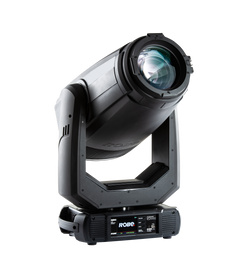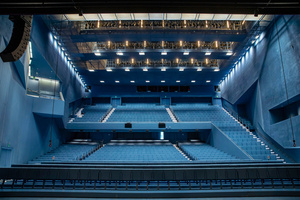Siège Social
Filliales
Business Development
Robe T1s go “Upstream” for National Ballet of Portugal Production
Produits liés
 T1 Profile™
T1 Profile™Groundbreaking choreographer and contemporary dance innovator Andrew McNicol presented the world premiere of “Upstream” his first collaboration with the Companhia Nacional de Bailado (CNB) – the National Ballet of Portugal – for which he asked acclaimed lighting designer Yaron Abulafia to create scenography and lighting for the performance which was staged at the São Carlos Opera House, Lisbon, Portugal.
“Upstream” was presented as part of a trilogy of works, together with “Baracco Concerto” by the late George Balanchine and “Workwithinwork” (which originally premiered in 1998) by William Forsythe – three distinctive works from very different eras and generations of choreographers based on classical dance.
Yaron was excited to use the CNB’s 20 x Robe T1 Profile moving lights – the only moving lights on the rig – as the backbone of his lighting design in addition to the large-scale lighting set up in the venue.
Yaron became involved in the piece at the very early conceptual stages of its development which enabled him to weave all the interactive elements together when imagining the production design.
He worked closely with costume designer Helena de Medeiros and composer Peter Gregson who created contemporary minimalist music to frame the piece, which was performed live by soloists from the Chamber Orchestra of Portugal.
When it came to lighting, Yaron wanted to recreate an underwater environment where everything is fluid and the quality of movement is softer, more nuanced, and rounded, engaging reflections and echoes in light and materials or impressions of sunlight filtering through the water and waves, peppering them with light, matching the energy and tempo of the music in abstract and mystical ways.
Upstream’s five movements each featured a different subaquatic setting that was defined with the minimal use of props and primarily by light and movement, transforming these and the overall spatiality and look of the stage.
A heat resistant, semi-transparent plastic foil material backdrop – divided into eight 1.5-metre-wide drops – was the main prop covering the entire upstage area. Powerful vari-speed fans were positioned either side and run at different speeds to create undulating asymmetric movements onto which Yaron projected ripple effects and watery textures both sides.
When lit from behind, it was near translucent, and when not directly lit, it caught reflections like a mirror … “combined with light it was a fantastic surface to recreate the ephemeral and transient nature of water patterns,” he explained.
Upstage of the backdrop was a black rear lighting / projection screen which when unlit looked like an infinity space and when lit created a contrast with the foil.
During his research for this project, among other things, Yaron was inspired by the vision of deep-sea shipwrecks.
All the key moments of “Upstream” were highlighted and accentuated with lighting effects and atmospheres created using the T1s.
Supported by a large generic rig in the house, Yaron relied on the subtleties and power of Robe’s dynamic lightsource to deliver a unique setting for each movement.
The first movement opened dramatically, with the reveal of 6 static dancer couples illuminated like sculptures in a near static scene with a tiny bit of motion from the foil which elicited a WOW from the audience before they had even moved onstage.
As an emotional vehicle it really worked presenting a first image with no sound or movement just lighting to reveal the mystery and magic of the piece.
The colours ranged through blues and turquoise, establishing a horizon and water.
The second section was one of the boldest for lighting and dance, a movement danced only by men with very expressive and intoxicating music. It started with light beams shooting in from the upstage right corner, then T1 gobos penetrated all over the space immersing the audience a bit like sunlight from above punching through water.
The solo developed into more interaction with the foil backdrop augmented with light from the T1s with softened optics buzzing up and down the foil strips, building gradually, with more T1s joining the action making reflections on the floor, enhancing and intensifying the effect.
“I so enjoyed how beautifully you can combine the T1’s colour mixing with the conventional halogen and HMI sources,” elucidated Yaron. “I embraced the two far edges of the spectrum in this section, and the T1 dealt with both in a very organic and elegant way!”
The third movement featured only female dancers, and this was lit more traditionally with PAR cans adding architectural like beams and casting silhouettes on their bodies which reflected their backs onto the foil. Functioning as a mirror, this highlighted the tensions between the silhouettes and their reflection.
The colours for this part roamed into the pastel areas with a range of delicate lavender hues.
The fourth section was the ‘awakening’. The full cast onstage in couples with more resistance and pressure between the partners and growing anxiety in the choreography and music. The skin tones of the dancers shifted to be starker, more textured and burnt, making the dancers pop out and engage more confrontationally with the audience.
The final part and conclusion began with the notion of a spiritual scene between the lead couple, where all the colours vanished, and stage turned monochrome emphasising departure and transformation or travelling to an after or other life in a different world with a combination of many pure black shadows, white light, and strong wind on the foil.
Yaron used the lighting to evoke themes of solitude and powerlessness, shifting from black-and-white into high impact reflective shimmering effects emanating from the centre of the foil, inviting the men to walk towards the unknown while women remained on the floor downstage for an epic visual ending.
The T1s were used as white high cross lights and key light in these final scenes with all the foil reflections created by multiple overlaid T1s coming from overhead, on the floor – at the front of stage next to orchestra pit – and from the side booms, together with one HMI source.
All the lighting was run through the CNB’s own control console. Yaron worked closely with their technical director Cristina Piedade and head of lighting / programmer, Pedro Mendes, plus the crew at São Carlos Opera House.
The T1 features Taron found most useful for this production include the “outstanding colour rendering and the general softness of the light output which made mixing and combining with a range of Lee filters in the conventionals very straightforward.”
He also notes that the T1 optics, frosts and zoom proved ideal for achieving the exact blurred edge effect that he wanted for some scenes.
“The T1’s brightness is great for a mid-to-large sized venue like this, where they can be very intense when needed,” he said. While the gobos were used sparingly, there was enough choice and capacity to blend them into subtler looks using the animation wheel plus shutters for de-focussing and getting the reflections travelling precisely throughout the space.
Multiple dimmer and movement effects also helped bounce anomalies and deviations of shuttered light seamlessly and smoothly between the foil and the stage.
Yaron is no stranger to energising dance pieces with his very individual sculpting of spaces with light that taps into the psychology and power of imagination and emotion, reinforcing the deep and poetic connection between movement, music and contemporary style that is expressed in McNicol’s storytelling by shifting atmospheres, moods, and suggestion.
Photo Credit: Yaron Abulafia
Précédent
Suivant
Découvrir plus de news
Groundbreaking choreographer and contemporary dance innovator Andrew McNicol presented the world premiere of “Upstream” his first collaboration with the Companhia Nacional de Bailado (CNB) – the National Ballet of Portugal – for which he asked acclaimed lighting designer Yaron Abulafia to create scenography and lighting for the performance which was staged at the São Carlos Opera House, Lisbon, Portugal.
Amazing, popular, charismatic, and award-winning American magician Mat Franco’s current Las Vegas residency – “MAGIC REINVENTED NIGHTLY” – is staged at the Mat Franco Arena at the LINQ Hotel+Experience, and is every bit THE hot-ticket in town – a fast-and-furious, thrilling show-stopper full of cool tricks and humor … immersing and delighting fans!
Lighting designer Jo Kilgour created edgy and graceful lighting for Hatupatu / Kurungaituku: a forbidden love, a breathtaking new aerial dance work produced by Aotearoa’s boundary-pushing kaupapa Māori theatre company, Taki Rua Productions. The work, written by creative director Tānemahuta Gray and Kapa Haka by Wētini Mītai-Ngātai, premiered at the Tãwhiri Warehouse in Wellington as part of the 2024 Aotearoa New Zealand Festival of the Arts.

The spectacular Taipei Performing Arts Centre (TPAC), which contains three world class performance spaces – The Grand Theatre, the Globe Playhouse, and the Blue Box, has recently invested in 40 x Robe Spiider LED wash beam luminaires, which will help light an array different of productions staged at the venue.
Naviguer
Connexion
Suivez-nous
Restons en contact
Naviguer
Connexion
Suivez-nous
Restons en contact
All rights reserved. Created by Appio
ROBE Lighting utilise des cookies. Nous utilisons des cookies pour personnaliser le contenu et les publicités et pour analyser notre trafic. Veuillez consulter « En savoir plus sur les cookies » pour en savoir plus sur la façon dont ils sont utilisés sur notre site Web. Cliquez sur "Accepter" pour les activer, autrement cliquez sur "Fermer et utiliser uniquement les cookies ne nécessitant pas de consentement". Vous pouvez modifier vos paramètres sur les "Cookies" dans le pied de page à tout moment.




